Advantage America
John Mauldin
September 10, 2013
 Today’s Outside the Box, which comes to us from good friend Gary Shilling, is unusual because that old confirmed bear is waxing positively bullish about the future prospects of the US. In doing so he mirrors my own views. It is just a matter of time before I go from being bearish on the US because of the dysfunctional US government to being an irrational perma-bull, at least for the next few decades. There is just too much upside potential with this country of ours — if we can muster the political will to handle our serious fiscal issues.
Today’s Outside the Box, which comes to us from good friend Gary Shilling, is unusual because that old confirmed bear is waxing positively bullish about the future prospects of the US. In doing so he mirrors my own views. It is just a matter of time before I go from being bearish on the US because of the dysfunctional US government to being an irrational perma-bull, at least for the next few decades. There is just too much upside potential with this country of ours — if we can muster the political will to handle our serious fiscal issues.
Gary builds the positive case beyond the fiscal concerns, and a compelling case it is. In six crucial areas, he says — demographics, entrepreneurial activity, labor relations, domestic vs. foreign debt financing, currency strength, and energy independence — the US is better positioned than any of its major competitors.
Gary pays particular attention to the importance of a strong US dollar. The dollar is not even close to being unseated as the world’s primary reserve and trading currency; but that is not to say there won’t be currency challenges ahead, with the biggest global currency war since the 1930s just getting fired up. Already competitive devaluations and protectionist measures are rampant around the globe. Can the US take the high road? If we want to maintain the privileged position of our currency, we must.
OTB readers can subscribe to Gary Shilling’s Insight for one year for $335 via e-mail. Along with 12 months of Insight you’ll also receive a free copy of his full report detailing why he believes it will be “advantage America” in the coming years and a free copy of Gary’s latest book, Letting Off More Steam. To subscribe, call 1-888-346-7444 or 973-467-0070 between 10 am and 4 pm Eastern time or email insight@agaryshilling.com. Be sure to mention “Outside the Box” to get the special report and free book in addition to your 12 months of Insight (available only to new subscribers).
I’m in Chicago this afternoon doing interviews and catching up on my reading before giving a speech this evening. Tomorrow morning I’m off to the Dakotas, where I will spend the day with oil entrepreneur Loren Kopseng talking about shale oil and gas. Coincidentally, I just got a question for Loren from the research team at Mauldin Economics. Can I ask him about the new, potentially $20-trillion shale oil find in Australia and what he thinks of it? I’m sure it won’t dampen his enthusiasm for all things Bakken, but it does go to illustrate that shale oil is not just a US phenomenon. Oil has always been there. It just takes technology and the willingness and ability to use it to get it out of the ground. Plus high enough energy prices, of course.
I have been reading about new shale oil discoveries all over the world. Enthusiasm about oil and gas discoveries in the eastern Mediterranean was palpable in Cyprus. I should note that it was a Texas company that was crazy enough to go after that oil, which will soon make Israel energy independent and supply a great deal of energy to Europe. And we note that Russia is very concerned about its potential port in Syria. Just a coincidence, I’m sure.
The first thought that leapt to mind upon reading the query about Australian oil was, “Ho-hum, yet another oil discovery.” But then the thought that followed very closely was that this is a country whose people more closely resemble crazy Texans than anyplace else I have been (and for whatever reason, I find that a good thing). There is plenty of capital Down Under, and it would not surprise me if they figured out how to exploit these shale oil reserves. I’ll have to do a little homework before I head out to Saudi Arabia in January. There will be interesting questions to ask my hosts. The world just keeps getting more interesting every day. (I just watched a lengthy presentation on robotics and continue to be amazed at the progress that is being made. Interesting times indeed!)
I’m not sure where I will be when I write this week’s letter, but it will show up again this weekend. And have a great week. ($20 trillion? Really? Really!?! And I thought Texas oil guys were irrationally exuberant.)
You’re fascinated by human ingenuity analyst,John Mauldin, Editor
Outside the Box
subscribers@mauldineconomics.com
Are you reading the right financial research?
Making profitable investment decisions start with access to the right financial information. Each week John Mauldin studies hundreds of articles and reports personally sent to him from his network of world-class money managers and investors. John understands that very few people can commit this kind of time to research and that even fewer have access to much of the analyses he receives. That is why he personally filters all of this information down to the most crucial items he feels you need to know. Find out how easy it is to look over John’s shoulder for the right information, today.
Advantage America
(excerpted from the July 2013 edition of A. Gary Shilling’s Insight)
Beyond what I believe are bright prospects for a return to rapid U.S. economic growth and the resulting decline in federal debt-to-GDP, Americans in future years will enjoy six major advantages over developed and developing country competitors in the globalized world.
1. Demographics
Demographics are one. The current immigration debate in Washington isn’t over throwing illegals out but over how to give them legal status and a path to citizenship while attracting highly educated and skilled newcomers. Only a few other countries such as Canada and Australia are at least as open as America.
Immigrants tend to be younger than current residents and have higher birth rates, especially Hispanics. So the U.S. fertility rate of 2.06 is close to the 2.1 births per child-bearing woman needed to sustain the population in the long run (Chart 1).
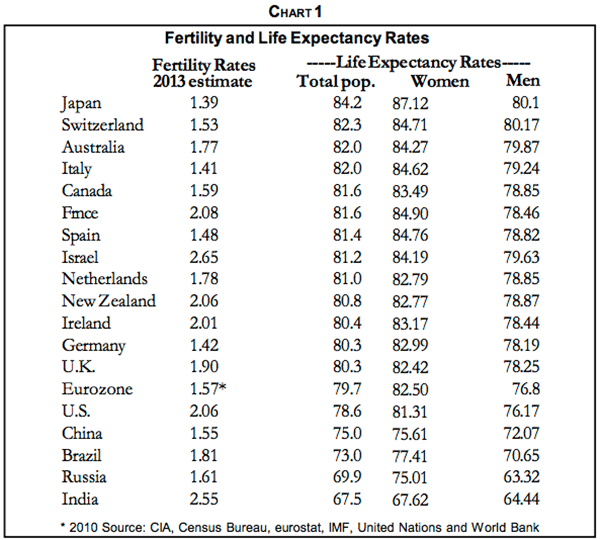
In contrast, the fertility rates in all European countries and even Canada and Australia are below the reproduction level. Japan’s, the lowest at 1.39, is compounded by the total lack of any immigration. China’s fertility rate is just 1.55 because of the one-child-per-couple policy, which the government is reconsidering.
Most immigrants have jobs, either those requiring high skills and education or low level work that natives shun. They’re not old enough to draw Social Security and Medicare benefits in large numbers but their payroll taxes help provide benefits for retiring postwar babies.
Because of aging populations in all major countries, immigrants are needed to keep the 15-64 working-age population from falling faster as a percentage of the total. By 2040, the U.S. ratio, 60.3%, is projected to be the highest of any developed country. China’s ratio falls rapidly from 72.4% in 2010 to 63.1% in 2040 due to its one-child policy, and already, new labor force entrants age 15-24 are declining in number.
Even if the 2 million people who left the labor force in the last two decades for non-demographic reasons never re-enter because their skills are rusty or they prefer disability benefits and food stamps, it won’t impede robust real GDP annual growth of about 3.5% after the Age of Deleveraging is completed. With 2.5% growth in productivity per year, employment would need to rise 1% annually. That’s about 1.44 million more workers per year.
The working-age population in future years is projected by the Bureau of Labor Statistics to rise about 2.2 million per annum. With the current participation rate of 64% (Chart 2), that would produce 1.4 million new job-seekers, about the same as new labor demand, assuming these new entrants’ skills match those that are needed. And a declining unemployment rate would add more to the employed.

2. Entrepreneurial Spirit
Another big advantage for the U.S. is the American entrepreneurial spirit, observed by de Tocqueville in the 1830s and still going strong today. Despite perceptions of an erosion of U.S. economic vigor, America still seems way ahead of whoever is in second place. It starts with the education system, which has many faults but does encourage free inquiry and the challenging of accepted doctrine.
Foreigners attending U.S. colleges and universities are often shocked when they are encouraged to question professors. Japan discourages individuality. “The nail that sticks up must be hammered down,” is their expression. Chinese education involves rote learning with no emphasis on student inquiry, begging the question: How is China going to grow after she gets her labor force fully employed and catches up to Western technology?
Furthermore, China’s economy remains heavily tied to bureaucratic, inefficient state-owned enterprises that produce about half of GDP and employ around a quarter of the labor force. Over half of companies listed on the Shanghai Stock Exchange are SOEs, the direct result of the government’s preference for them as IPO issuers while private businesses are starved for capital. SOEs are so inefficient that they require loans at sub-market rates from the government banks, subsidized by low deposit rates.
Government direct subsidies to about 90% of the companies listed on China’s stock exchanges, most of them SOEs, were up 23% last year to $13.8 billion. These subsidies were equal to 4% of total profits, which rose less than 1% and were in the form of cheap land, tax rebates, support for loan repayments and simple cash. Without subsidies, many Chinese companies would fail due to excess capacity and weak export demand.
With the renaissance of U.S. oil and gas production and resurgence of robotic and capital-intensive manufacturing, the U.S. bested China for the first time since 2001 as the more favorable place for foreign direct investment, according to a recent survey (Chart 3).
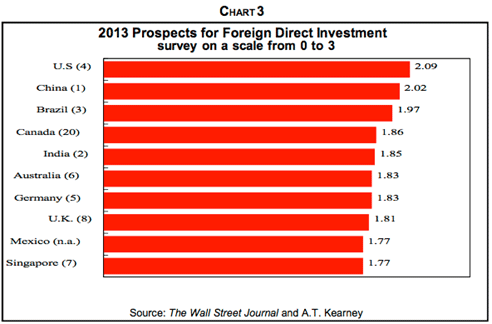
Leaping American oil and gas production has created a global energy supply cushion that allows the U.S. to deal with Iran and other trouble spots without debilitating spikes in oil prices.
3. Labor Flexibility
An added long-term advantage for the U.S. in international competition is her flexible labor markets. Labor unions are becoming a thing of the past, especially in the private sector and now increasingly among state and local employees (Chart 4). Partly as a result, U.S. wages are flexible on the down side. Surveys show that of the people out of work for six months (Chart 5) who do find new jobs, a third work for less money than previously.
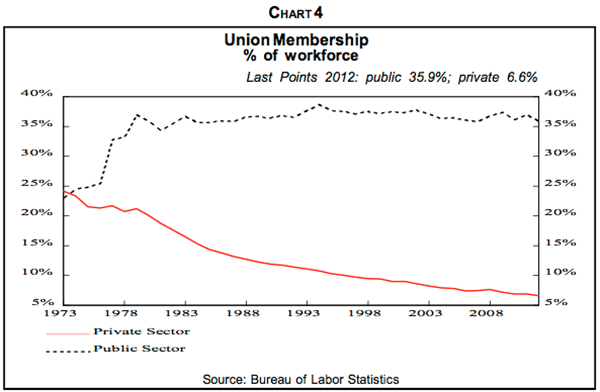
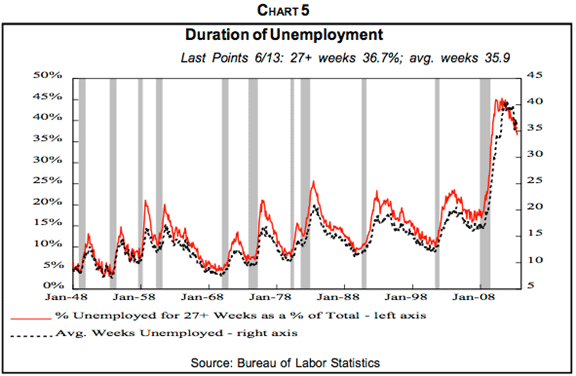
Working for less is almost unheard of in Europe and lifetime employment is the rule in Japan. China is increasing minimum wages about 25% per year to provide more consumer spending power as she strives to shift from an export-led to a domestically-driven economy. But higher wages erode the global competitiveness of China and production is shifting to cheaper locales like Vietnam, Bangladesh and Pakistan.
The auto industry is a case in point. After the Great Recession drove GM and Chrysler into bankruptcy, U.S. automakers introduced $14 per hour wages for new employees, half the level of veterans. So in 2011, the average pay of U.S. autoworkers including benefits was $38 per hour compared to $66 in Germany and $37 in Japan. U.S. pay has increased $3 per hour since 2007, but $12 in Japan and $14 in Germany. As a result, vehicles from U.S. auto plants are beginning to be shipped abroad in numbers.
4. Declining Need For Foreign Financing
An additional major advantage for the U.S. in future years is the likely decline in dependence on foreign financing. The current account deficit measures the extent that U.S. investment exceeds the combined saving of consumers, business and government. With consumer saving low and large federal deficits, the current account deficit has been sizable, about $400 billion at annual rates. This deficit is financed by increases in foreigners’ holdings of stocks, Treasurys, real estate, etc., as they recycle dollars back to dollar-denominated investments.
I don’t share the fears of some that the Chinese or others will dump their huge holdings of Treasurys and other dollar-denominated securities (Chart 6). They’re not suicidal, and if they started selling, the value of their remaining Treasurys would collapse and a global recession would no doubt follow as interest rates skyrocketed. China and other export-led economies would be the big losers in the resulting buyers’ market.

But accidents can and do happen, so America’s global status will improve if the trade and current account deficits shrink. That’s likely if my forecast of a rise in the household saving rate back to double digits unfolds (Chart 7).
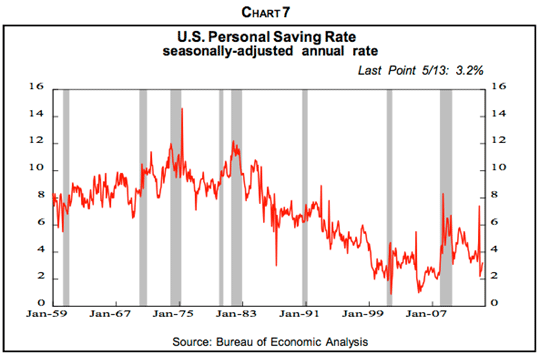
As I’ve discussed in my recent book, The Age of Deleveraging, and in many past Insight reports, Americans have little choice but to save more. They no longer trust their stock portfolios as they did in the 1980s and 1990s to substitute for saving out of current income to educate their kids and finance early retirement. The nosedive in house prices after heavy cash-out refinancing of mortgages and home equity loans has removed much of the home equity they earlier used to finance oversized spending. The postwar babies have been notoriously poor savers and desperately need to keep working and save much more for their old age.
As the saving rate rises, spending will grow more slowly, the reverse of what occurred when the saving rate slid from 12% in the early 1980s to 1%. That drove consumer spending growth about a half-percentage point per year faster than after-tax income and fueled the domestic economy. It also propelled the many Asian and other lands whose economies are driven by exports, largely to U.S. consumers. For every 1% rise in American consumer spending, U.S. imports—the rest of the world’s exports—rise 2.8% on average.
A rising consumer saving rate will retard the growth in spending on everything, including imports. This will curtail the exports of export-led economies like China, whose leaders are aware of this likelihood and are working to shift that economy to domestic emphasis. In any event, the resulting shrinking of the U.S. trade and current account deficits will put fewer dollars in foreign hands that will be recycled into U.S. investments.
But fewer will be needed since money is fungible, and the high consumer saving will provide more money to replace foreign funds in financing the federal deficits and other needs. At a 10% household saving rate, $1.2 trillion would be available to finance federal deficits, now less than $1 trillion, as well as business net borrowing.
On balance, the U.S. will meet more of its financing needs internally, but probably not all. If the American trade and current account deficits disappeared completely, the many Asian, Latin American and other import-led economies would be in severe trouble until they converted to domestically-driven states. Also, without U.S. current account deficits, the dollars that almost every foreign country depend on as their primary reserve currency would be difficult to accumulate.
Needless to say, as long as the economies and other developing countries remain export-led, they will be coupled to the economic health of the buyers of their exports, principally the U.S. and Europe. In the fall of 2007, on the eve of the Great Recession, many thought that China and India would lead global growth and indeed support the U.S. economy as the American housing and consumer sectors faltered.
Nevertheless, we wrote in “The Chinese Middle Class: 110 Million Is Not Enough” (Nov. 2007 Insight), that China’s middle class, those with discretionary spending power, was growing but not yet big enough to carry the economy. Ditto for India. We predicted that “the looming U.S. recession will spread globally,” including to China.
Well, as they say, the rest is history. China’s growth collapsed to recession levels (Chart 8) and was only revived by massive government stimuli. China’s middle class is growing rapidly, but domestic spending is not yet big enough and China’s exports are still important enough to keep her coupled to the West. This dependency is magnified by her immense excess capacity problem and ongoing financial crisis. It will probably take about a decade before China’s domestic economy can carry the economic ball.
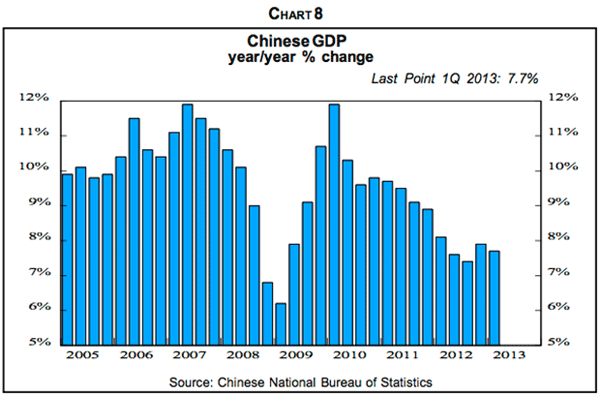
5. Strong Dollar
A rising dollar is another long-run advantage for the U.S. in the global arena, reflecting the economic, political and financial strength of America as well as the buck’s continuing status as the world’s primary reserve and trading currency.
A review of history since ancient times reveals six characteristics of a dominant global currency. The buck will likely remain the winner in at least five of the six for many years.
1. Rapid growth in the economy and GDP per capita, promoted by robust productivity growth. This is probably the most necessary condition for a dominant international trade and reserve currency. It was key to British sterling’s success in the 19th century and the dollar’s superior position since then. It’s also necessary to support globally-dominant military structures in modern democracies while still satisfying voters with acceptable standards of living.
In the last decade, the U.S. has excelled in productivity gains among developed areas. Her emphasis on entrepreneurial activity and American superiority in new technologies suggest this lead will persist.
2. A large economy, probably the world’s biggest. That was true of ancient Rome, which had an unusually effective administration and centralized control for the times. With the breakdown of communications in the Middle Ages, size was less important and allowed relatively small Italian city-states and their currencies to achieve international primacy. In modern times, Singapore and Switzerland meet our other qualifications but are just not big enough to have primary currencies.
With rapid productivity growth and relatively open immigration, America will probably continue in this role. Population is falling in Japan and will soon follow in other developed lands as well as China with her one child-per-family policy.
3. Deep and broad financial markets. Internationally, money—especially today when it can be transferred anywhere in a split second—wants to be where the action is. That requires not only a powerful and large economy but also deep and broad markets in which to invest. Today, the U.S. Treasury market trumps all others in size and, in the eyes of investors (Chart 9), in safety as witnessed by the mad rush into Treasury bonds in times of recent global trouble.
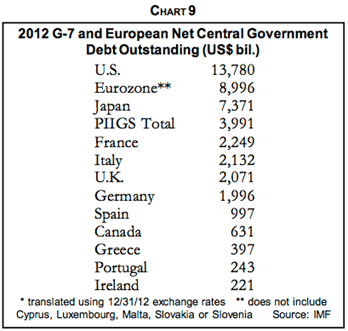
Similar American stock market capitalization is four times that of China, Japan or the U.K. and is over three times the eurozone’s (Chart 10). Almost 50% of Treasurys are held by foreigners but only 9.1% of Japan’s government net debt is owned by non-Japanese. According to the IMF, 62% of the world’s currency reserves are in dollars. The 24% in euros is down from 29% four years ago. Foreigners so love investing in the U.S. that at the end of 2012, it exceeded U.S. investment abroad by $4.4 trillion, up from $4 trillion a year earlier.
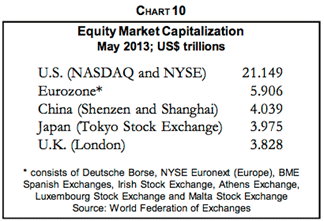
4. Free and open financial markets and economy. Foreign investors are willing to hold a country’s currency if they are convinced they can invest it in financial or tangible assets in that country with few restrictions. The U.S. is essentially open, which is necessary if the Chinese and Japanese are to continue to recycle their current account surpluses with the U.S. into Treasuries and other American investments.
Free and open markets persist in the U.S. but less so in Europe with the eurozone crisis. China will probably continue to control tightly her financial markets and currency, anathema for an international trading and reserve currency. Nevertheless, China is relaxing control of her currency slowly and the yuan has surpassed the Russian ruble and the Danish krone to become the world’s 13th most used currency for international payments.
5. Lack of substitutes. A primary global currency, by definition, has no close competitors. The risk is that the top dog gets fat and lazy while upstarts surpass it in productivity growth, and ultimately, in GDP-per-capita or GDP-per-employee. That’s how the Dutch lost out to the British in the late 1700s, and in turn, the U.K. was overrun by the U.S. a little more than a century later.
Today, the rigidly controlled Chinese economy and financial markets eliminate the yuan as a rival to the dollar for the foreseeable future. Export-dependent and inward-looking Japan does not want the yen to be a primary global currency. And the ongoing eurozone financial crisis and recession eliminate the euro for at least a number of years.
6. Credibility in the value of the currency. Internationally, money is fleet-footed, congenitally cautious and runs from uncertainty over risk of confiscation, debasement, etc., as discussed in our earlier review of history. The Roman aureus, the Byzantine solidus and the Arabian dinar all went out of international style when those empires waned, but the related debasement of those currencies speeded the exit. On the flip side, in World War I, Britain went off the gold standard only to return in 1925 with the prewar price of gold in sterling. With immense wartime inflation in the interim, that action vastly overpriced sterling, causing uncertainty and leading to a mass exodus of U.K. money to New York and elsewhere.
Credibility in the dollar has been strained by its overall decline since 1985 (Chart 11), but still is substantial. The troubling current account deficit will probably continue to shrink as retrenching consumers moderate imports, as discussed earlier, as U.S. production becomes increasingly competitive, and as net U.S. energy imports move toward exports. Also, in effect, competitive devaluations will ultimately be against the U.S. dollar. This will only add to the greenback’s luster as the only safe haven currency of any size in a persistently uncertain world.
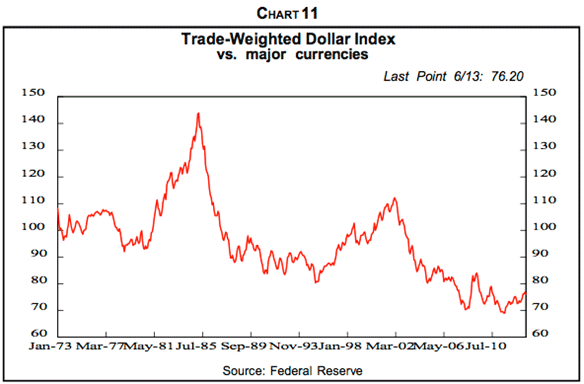
6. Energy Independence
America is on her way to self-sufficiency in energy. To the dismay of Peak Oil devotees, horizontal drilling and fracking technology have unlocked from shale oceans of natural gas and petroleum. Combined with the oil sands in Canada and other nonconventional sources of energy as well as higher auto fuel-efficiency and other conservation measures, there are predictions that the U.S. could be relatively free from foreign oil dependence by 2020. Cheap natural gas is a competitive advantage for U.S. producers, especially of petrochemicals and nitrogen fertilizers.
Leaping American oil and gas production has created a global energy supply cushion that allows the U.S. to deal with Iran and other trouble spots without debilitating spikes in oil prices.


What's been said:
Discussions found on the web: